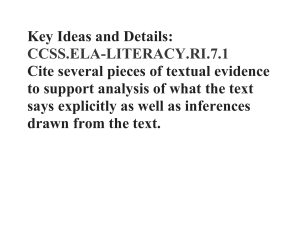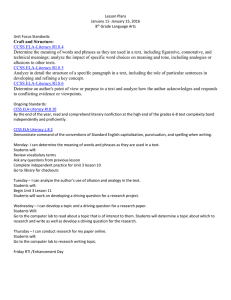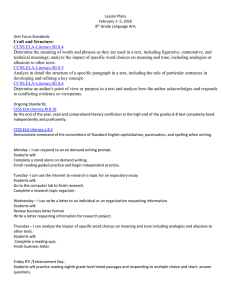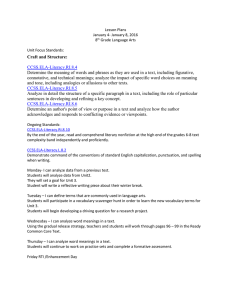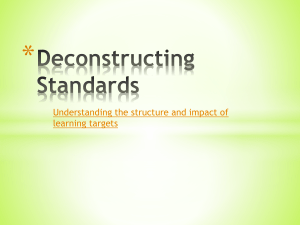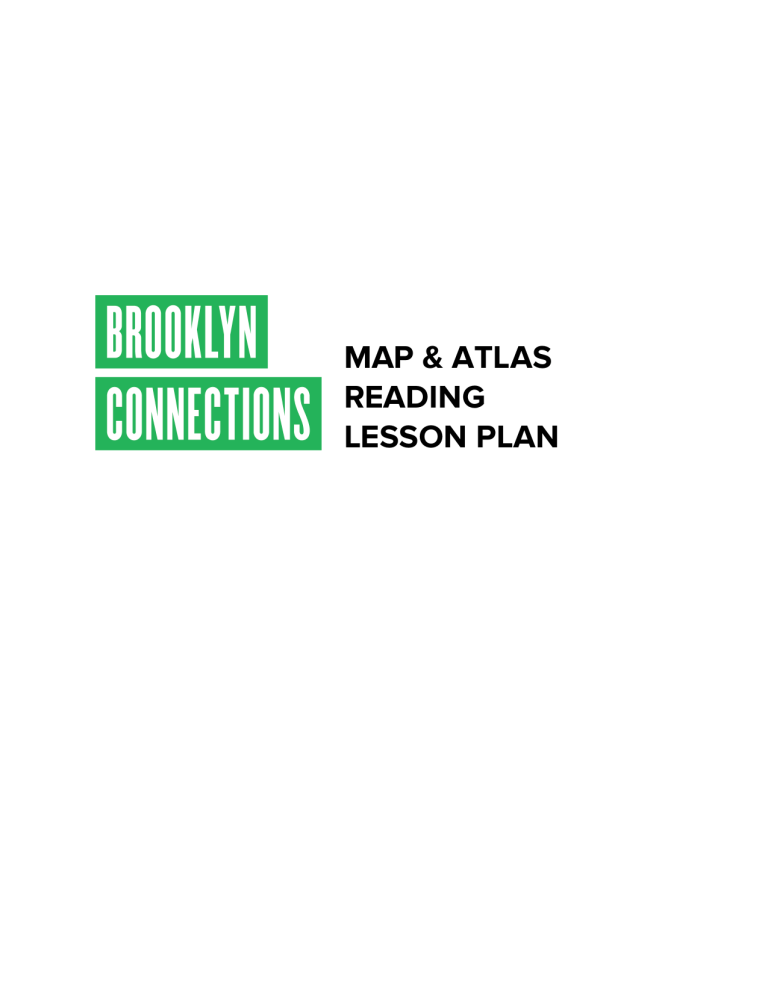
MAP & ATLAS READING LESSON PLAN AIM: Students learn how to interpret map and atlas keys and pages. OBJECTIVE: Students practice comparing and contrasting different map and atlas pages, close reading of atlas keys and applying their knowledge to make inferences regarding development and population changes MATERIALS: • • • • • PROCEDURE: Prezi: http://prezi.com/nygrdhmayar1/?utm_campaign=share&utm_medium=copy&rc=ex0share Atlas Key and Atlas Page Map Atlas Reading Guided Questions (Handout) SmartBoard or Projector for guided instruction 1. 2. 3. 4. 5. 6. 7. 8. 9. 10. Set the Scene a. What does rural mean? What does urban mean? b. Have students describe a rural place. c. Ask students to think back 100 years – What do you think the area around xxx looked like in (specific year)? Introduce Atlases Explain difference between atlases and maps: Maps often show wide areas, unspecific; Atlases are a book of maps that often shows landmarks, more specific Introduce Atlas Keys: Keys decipher maps and atlases Distribute the first Atlas Key (one per two students) a. Students will note the date of the atlas b. Students will locate the colors associated with building materials c. Students will locate trolley lines and elevated rail lines d. Students will locate words they do not know Distribute the Atlas page (one per two students) a. Students will orient themselves by naming streets they recognize.If possible, educator can use GoogleMaps to help students orient themselves b. Students will spend five (5) minutes examining the page by using the key; use the following focus questions: i. What were the streets made of? ii. What were the buildings made of? iii. Is the neighborhood urban or rural? c. Students will be asked to describe the area around xxx in (specific year) in their own words, citing evidence from the atlas page. d. Students will be asked to make inferences as to how they believe the area will change in 10 years. Distribute second Atlas Key (one per two students). Have students compare first atlas key to second atlas key. What is different? Distribute second Atlas Page a. Students will spend five (5) minutes examining the page thinking about the following focus questions: i. How have the streets changed? ii. How have the buildings changed? iii. What new features or landmarks have been added? b. Students will be asked to draw conclusions as to how the area changed over xxx years in their own words using evidence from the atlas pages. Students will be asked if their inferences were correct – if incorrect, what was incorrect about them. Students will then be asked to ask a question they have about the neighborhood MAPS & ATLASES LESSON PLAN and its evolution. 11. If time allows, students can follow steps 6 and 7 using a third atlas key and page. MAPS & ATLASES LESSON PLAN ASSESSMENT: • Assess using steps 5c and 7b: students should use their own words and articulate what the (specific area) looked like in (specific year) and how the area changed between those two years. Students must cite evidence from the atlas page. DIFFERENTIATION: • For higher level students, add the third atlas page and ask them to make larger comparisons. For lower level or beginning students, utilize one atlas page and spend more time constructing a clear picture of the area represented. Use GoogleMaps or other current map sources to help orient students If students are having trouble thinking up questions, ask them to use one of the following words as a starting prompt: Who, What, When, Where, Why, ie: o Who moved in to the area when it was growing? o Why was the area so rural when other parts of the borough were not? • • • C.C.S.S. ADDRESSED: 4th Grade CCSS.ELA-Literacy.RI.4.9 Integrate information from two texts on the same topic in order to write or speak about the subject knowledgeably. CCSS.ELA-Literacy.W.4.7 Conduct short research projects that build knowledge through investigation of different aspects of a topic. CCSS.ELA-Literacy.W.4.9 Draw evidence from literary or informational texts to support analysis, reflection, and research. 5th Grade CCSS.ELA-Literacy.RI.5.9 Integrate information from several texts on the same topic in order to write or speak about the subject knowledgeably. CCSS.ELA-Literacy.W.5.7 Conduct short research projects that use several sources to build knowledge through investigation of different aspects of a topic. CCSS.ELA-Literacy.W.5.9 Draw evidence from literary or informational texts to support analysis, reflection, and research. 6th Grade CCSS.ELA-Literacy.W.6.9 Draw evidence from literary or informational texts to support analysis, reflection, and research CCSS.ELA-Literacy.WHST.6-8.1a Introduce claim(s) about a topic or issue, acknowledge and distinguish the claim(s) from alternate or opposing claims, and organize the reasons and evidence logically. CCSS.ELA-Literacy.RH.6-8.1 Cite specific textual evidence to support analysis of primary and secondary sources 7th Grade CCSS.ELA-Literacy.W.7.9 Draw evidence from literary or informational texts to support analysis, reflection, and research CCSS.ELA-Literacy.WHST.6-8.1a Introduce claim(s) about a topic or issue, acknowledge and distinguish the claim(s) from alternate or opposing claims, and organize the reasons and evidence logically. CCSS.ELA-Literacy.RH.6-8.1 Cite specific textual evidence to support analysis of primary and secondary sources 8th Grade CCSS.ELA-Literacy.W.8.9 Draw evidence from literary or informational texts to support analysis, reflection, and research CCSS.ELA-Literacy.WHST.6-8.1a Introduce claim(s) about a topic or issue, acknowledge and MAPS & ATLASES LESSON PLAN distinguish the claim(s) from alternate or opposing claims, and organize the reasons and evidence logically. CCSS.ELA-Literacy.RH.6-8.1 Cite specific textual evidence to support analysis of primary and secondary sources 9th – 10th Grades CCSS.ELA-Literacy.RI.9-10.1 Cite strong and thorough textual evidence to support analysis of what the text says explicitly as well as inferences drawn from the text. CCSS.ELA-Literacy.RL.9-10.1 Cite strong and thorough textual evidence to support analysis of what the text says explicitly as well as inferences drawn from the text. CCSS.ELA-Literacy.W.9-10.9 Draw evidence from literary or informational texts to support analysis, reflection, and research. CCSS.ELA-Literacy.RH.9-10.1 Cite specific textual evidence to support analysis of primary and secondary sources, attending to such features as the date and origin of the information. 11th- 12th Grades CCSS.ELA-Literacy.RL.11-12.1 Cite strong and thorough textual evidence to support analysis of what the text says explicitly as well as inferences drawn from the text, including determining where the text leaves matters uncertain. CCSS.ELA-Literacy.RI.11-12.1 Cite strong and thorough textual evidence to support analysis of what the text says explicitly as well as inferences drawn from the text, including determining where the text leaves matters uncertain. CCSS.ELA-Literacy.W.11-12.9 Draw evidence from literary or informational texts to support analysis, reflection, and research. CCSS.ELA-Literacy.RH.11-12.1 Cite specific textual evidence to support analysis of primary and secondary sources, connecting insights gained from specific details to an understanding of the text as a whole. MAPS & ATLASES LESSON PLAN NAME: ______________________ MAPS AND ATLASES 1. What types of things appear on maps? 2. Name two big landmarks in Brooklyn (ie bridges, parks, museums, etc.): LOOK FIRST AT THE MAP PROVIDED: 1. What is the title of the map? 2. What year is this map from? 3. Make five observations about the map. • • • • • 4. Count how many ferry lines you see on this map. ATLAS (1929) Locate the compass on the atlas page. Situate the atlas page so north is pointing away from you. 1. What is one main difference between the map and this atlas page? 2. What types of materials are the buildings made out of? 3. List four businesses that you see: 1. 2. 3. 4. 4. Locate trolley lines. What streets are the trolley lines on? 5. According to this atlas page, what is going to be constructed on Manhattan Ave? 6. Describe what it might have felt like to live in this neighborhood in 1929. What would you hear? What would you see? What type of work would you do? MAPS & ATLASES LESSON PLAN MAPS & ATLASES LESSON PLAN MAPS & ATLASES LESSON PLAN

